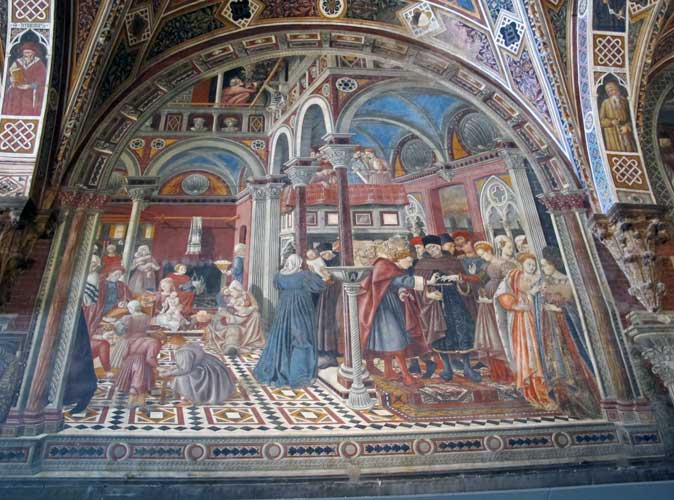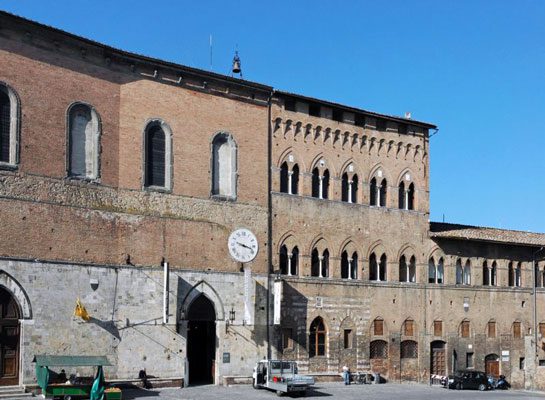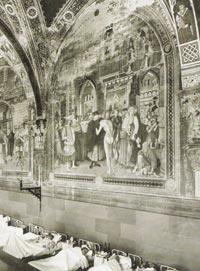Sally Metzler
Chicago, Illinois, United States
These frescoes by Domenico di Bartolo (active 1420-1444), a stalwart of Sienese Renaissance painters, illuminate daily life in one of Europe’s oldest hospitals, the Ospedale di Santa Maria della Scala. Situated across from the magnificent Gothic Siena Cathedral, the Ospedale was admired in the fifteenth century for its expert care of the sick, pilgrims, and abandoned children. The canons of the Cathedral founded the Ospedale in the 10th century, although legend credits a shoemaker for its inception. Continuing as a hospital until the 1990s, it is now a cultural landmark for the walled city of Siena.
 |
|
Care of the Sick, 1441-42 |
During the fifteenth century, the Ospedale commissioned an extensive decorative program that can still be admired today, particularly the frescoes for the Pellegrinaio, or the Pilgrims Hall. Di Bartolo, along with fellow Sienese artists Vechietta and Priamo della Quercia, painted a fresco cycle narrating the progressive practices carried out by the Ospedale staff. Di Bartolo’s scene, enlivened by rich descriptive detail, shows doctors tending patients. On the left, two physicians examine the urine in a glass vessel. A patient below lies on a stretcher, his countenance full of trepidation. The center scene displays a patient with a bleeding thigh wound being prepared for an operation, a thorough washing of the feet among the rituals. On the right, the painter made a veiled critique of the benevolent, yet decidedly, corpulent monk who hears the confession of a man in bed. Although the Siena hospital distinguished itself in the Renaissance for its high level of cleanliness and order, Bartolo nonetheless included cats and dogs in the scene, characters not welcome in today’s sterile medical environment.
 |
|
Marriage of The Foundlings Wall, ca. 1444 |
In this next fresco, Di Bartolo describes another key function of the hospital, the rearing of orphans, or as they were known in Siena—“the gettatelli.” The hospital systematized their care from infancy to adulthood, applying enlightened methods. If the orphans arrived as babies, meticulous records were maintained should the parents ever wish to reclaim their children. Di Bartolo shows a mother in the center of the composition handing over her swaddled baby to the care of a hospital official. She shows subdued emotion, save for a scintilla of remorse as the baby grimaces with apprehension. But the overall calmness of a typically intense emotional event reflects the mother’s confidence in the expert care of the Ospedale. Thus the journey of childhood begins at the Ospedale, where the child would be fed, clothed, and educated. On the left, a stern teacher instructs a child, albeit allowing time for play, as witnessed below by the smiling faces. At the age of eight, the child could select and learn a trade. While working, all wages earned by the orphans were saved by the Ospedale, but when the child turned 18 and was ready to leave for the outside world, the Ospedale returned their wages. The orphan girls, if they elected, could marry and raise a family. In this case, they received an extra 50 soldi for their dowry. On the right, the wedding of an orphan bride is taking place, and Di Bartolo has painted a girl dressed in finery, demonstrating that the Ospedale treated her to a wedding worthy of any lady.
In the Ospedale frescoes, Di Bartolo aligns himself more with the muscular naturalism of the Florentines than the ethereality of the Sienese painters. Indeed, he was among the few Sienese painters who also worked in Florence. The Ospedale frescoes made their mark in art for their departure from the Sienese gold ground paintings populated by lithe and lyrical figures. Although minor flaws in perspective are evident, Di Bartolo’s frescoes for the Pilgrims Hall of the Ospedale di Santa Maria della Scalla display a wealth of detail and precious insight into the medical treatment and care of Renaissance Sienese citizens.
 |
 |
|
Façade of the former Hospital Santa Maria della Scala, now a museum. |
Santa Maria della Scala served as a hospital from the 10th century until 1996 |
Note
- For more information on the history of the hospital, please read “The Hospital of Santa Maria della Scala, Siena, 1090-1990,” by Dr. Hugh Baron, published in the British Medical Journal, vol 301, 22-29 December 1990.
SALLY METZLER received her PhD in Art History from Princeton University. Currently, she is Guest Curator at the Metropolitan Museum of Art in New York.
Highlighted in Frontispiece Winter 2013 – Volume 5, Issue 1
Winter 2013 | Sections | Art Flashes

Leave a Reply